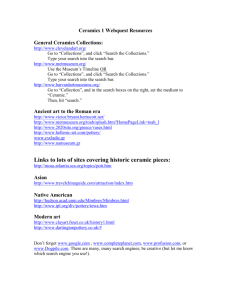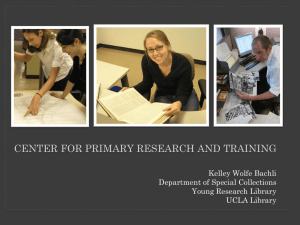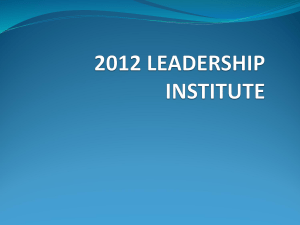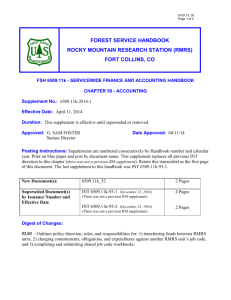ProposalExpansion_RMRS-NASA_SiberiaFireHistory_040812
advertisement
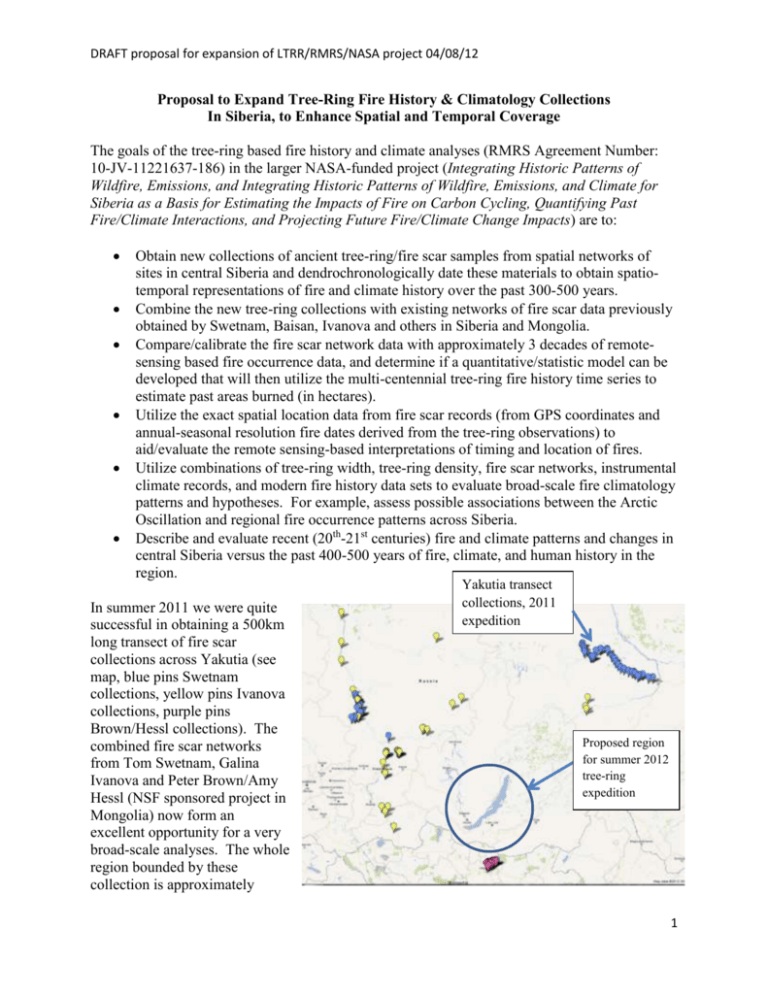
DRAFT proposal for expansion of LTRR/RMRS/NASA project 04/08/12 Proposal to Expand Tree-Ring Fire History & Climatology Collections In Siberia, to Enhance Spatial and Temporal Coverage The goals of the tree-ring based fire history and climate analyses (RMRS Agreement Number: 10-JV-11221637-186) in the larger NASA-funded project (Integrating Historic Patterns of Wildfire, Emissions, and Integrating Historic Patterns of Wildfire, Emissions, and Climate for Siberia as a Basis for Estimating the Impacts of Fire on Carbon Cycling, Quantifying Past Fire/Climate Interactions, and Projecting Future Fire/Climate Change Impacts) are to: Obtain new collections of ancient tree-ring/fire scar samples from spatial networks of sites in central Siberia and dendrochronologically date these materials to obtain spatiotemporal representations of fire and climate history over the past 300-500 years. Combine the new tree-ring collections with existing networks of fire scar data previously obtained by Swetnam, Baisan, Ivanova and others in Siberia and Mongolia. Compare/calibrate the fire scar network data with approximately 3 decades of remotesensing based fire occurrence data, and determine if a quantitative/statistic model can be developed that will then utilize the multi-centennial tree-ring fire history time series to estimate past areas burned (in hectares). Utilize the exact spatial location data from fire scar records (from GPS coordinates and annual-seasonal resolution fire dates derived from the tree-ring observations) to aid/evaluate the remote sensing-based interpretations of timing and location of fires. Utilize combinations of tree-ring width, tree-ring density, fire scar networks, instrumental climate records, and modern fire history data sets to evaluate broad-scale fire climatology patterns and hypotheses. For example, assess possible associations between the Arctic Oscillation and regional fire occurrence patterns across Siberia. Describe and evaluate recent (20th-21st centuries) fire and climate patterns and changes in central Siberia versus the past 400-500 years of fire, climate, and human history in the region. In summer 2011 we were quite successful in obtaining a 500km long transect of fire scar collections across Yakutia (see map, blue pins Swetnam collections, yellow pins Ivanova collections, purple pins Brown/Hessl collections). The combined fire scar networks from Tom Swetnam, Galina Ivanova and Peter Brown/Amy Hessl (NSF sponsored project in Mongolia) now form an excellent opportunity for a very broad-scale analyses. The whole region bounded by these collection is approximately Yakutia transect collections, 2011 expedition Proposed region for summer 2012 tree-ring expedition 1 DRAFT proposal for expansion of LTRR/RMRS/NASA project 04/08/12 2,000 km east-west and north south (about the size of the western United States). We now have an opportunity to carry out another expedition in summer 2012 that will enable us to obtain fire scarred material from the region around Lake Baikal (see map), i.e., in the Republic of Buryatia. This region is important and interesting for a number of reasons. For one, it is a world heritage natural area of extraordinary biodiversity. Second, areas to the east and north of Lake Baikal have experienced very extensive fires in recent decades. Third, for our fire scar network studies, a collection set from this region will provide data from a previously un-sampled area. And last, but not least, we have very good cooperation and offers of help from Siberian scientists and academicians in the region to support and help carry out the expedition. In particular, Academician Eugene Vaganov (Rector of the Siberian Federal University in Krasnoyarsk, a world leader in dendrochronology) is personally interested in this expedition. He may participate in some days of the travel and collections and he has assigned Assistant Professor Alexi Grachev (SFU) to assist in the planning and logistic arrangements for the expedition. We will also have good support from local academic/science institutions and permissions from government officials, because Dr. Vaganov and Dr. Grachev have strong collaborative connections in this region. Our plan for this trip is to spend approximately two weeks (including travel from/to Tucson), and to obtain up to 20 site collections along transects on the east side of Baikal (analogous to 2011 Yakutia trip in extent). We have prepared a budget itemizing the expected expenses by general category. We also itemize funding for our colleagues in Yakutia (Dr. Anatoly Nikolaev) to revisit some of the sites we sampled in 2011 where we obtained very old tree-ring material (up to 1,000 years!) to obtain additional specimens and to ship them to Tucson. In this proposal to expand our current project and agreements with the RMRS, there are several justifications, in addition to the scientific opportunities: Our existing agreement (recently extended to June 30, 2012) now has a balance of $xx,xxx total unexpended/unencumbered funds. Although in the original proposal we anticipated possibly mounting a second expedition to Siberia, we planned to do this only if funds allowed. The 2011 expedition was more expensive than originally planned (costs were about $40,000 for all travel, collections, and shipping wood). We did save funds on our plan to engage a masters degree student at University of Arizona, because we were unable to find a suitable Russian student for this position. The alternative we settled on was to provide field training for one of Galina Ivanova’s students (Sergey Zhila), who accompanied us in summer 2011, and also to host Mr. Zhila in Tucson for a month or so of training in fall 2012, or spring 2013. However, to carry out tree-ring dating work at Tucson of specimens, we have expended more funds on Senior Research Specialist Chris Baisan’s time, and we have engaged one of Swetnam’s PhD graduate students (Chris Guiterman) to assist in summer collections, tree-ring dating work and analyses. The proposed plan to provide some funding to Dr. Nikolaev in Yakutia for additional collections in summer 2012 is based on the demonstrated opportunity to obtain very long climate and treering history from selected sites. Further, this continued collaboration with Dr. Nikolaev and his students will likely benefit the project in facilitating access to his network of ring-width and ring density chronologies in Yakutia. 2 DRAFT proposal for expansion of LTRR/RMRS/NASA project 04/08/12 Given the expected funding needs for a 2012 expedition to Buryatia, and the additional funds for Dr. Nikolaev, see the budget for the expanded work below: Item: Cost: Airline tickets, Tucson/Ulan Ude (4 scientists @ $4,000 each) $16,000 Meals, lodging and field assistance/ expenses in Siberia for approx. 2 weeks $19,000 Air shipping of wood samples Ulan Ude to Tucson (about 200 kg) $5,000 Additional collections in Yakutia, by Anatoly Nikolaev, including shipping to Tucson from Yakutsk $10,000 Total Cost: $50,000 (UA Indirect Cost Return is normally 51.5%; because this ICR is not provided by USDA/RMRS by policy, this amounts to $25,750 cost share by UA.) We request that the current RJVA be modified with these new funds, and at the same time a new end date for the overall project be extended to June 30, 2013. Also, it is important that these new funds and agreement modification be in place before May 1st 2012, if at all possible, so that we may purchase plane tickets at a good price, and also confirm with our Russian colleagues so they can proceed with their planning. 3






